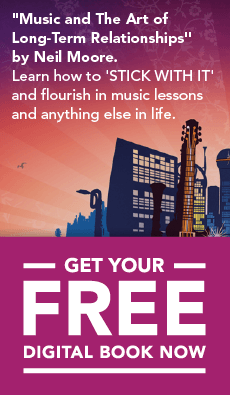Written by: Page Stegner
It is not as intimidating as one might think!
15-year-old level 3 Simply Music student Antoine ROCKED the house when he jammed for the first time with my band ‘the Smokin’ Rats’. As Antoine stepped through the front door his eyes grew big as saucers at the sight of the set-up stage that he would be performing on. He was also wearing a grin from ear to ear and it took no arm-twisting to sit him down behind the keys. “Okay gentlemen”(and I use that term loosely) I said, “let’s play a 12 bar blues in the key of C.” “Is that a quick to the IV?” asked Big Don the bass player. “Yes, Quick IV.” And the music kicked off. There was nothing but grins and smiles as I looked around at the fans and band members. As we brought the song to a close the house roared with cheers for the kid playing the keys; there too was a very proud smile on his father’s face.
Throughout the next three hours I coached Antoine on the craft of listening to what other musicians were doing, when to play, when not to play, when to get loud, when to get quiet, when to play fewer notes rather than more, when to look up and around and get your cues from the faces of others. I could tell that by the end of the evening he was on cloud nine just as I had been after my first time playing with other musicians in that kind of setting.
The first instrument that typically springs to mind when we think of playing in a band is probably guitar, and I concur with Ray Nelson when he says that there is no shortage of guitar players in the world — I’m even a member of that fraternity myself. The structure under which guitar is taught is one of chords, which equals accompaniment. Generally speaking, a person will learn three chords on the guitar and then put a lead sheet (a song with its chords and lyrics) in front of them. They will strum one time and sing to the next chord change; them strum the next chord one time and sing to the next chord change; it is so easy and natural that it is almost thoughtless. What is not so easy and natural on guitar is training your fingers to switch chords and have every note ring true and clear. That takes time and perseverance.
Piano on the other hand is a delightfully different experience altogether, because training your hand to play a chord takes very little time at all. It’s amazing to me that so many piano students never learn how to play chords and follow lead sheets, since that’s often all they would learn on guitar, and it’s probably easier on piano! It may take a few days if you have never even touched a piano, but if you have, learning to play a chord is almost instantaneous. No sore fingers from pushing your soft fleshy fingertips down on cold steel strings, no head scratching about whether your fingers are on the correct strings.
Now that you have put a week or two of practice and processing this concept on the piano, you are ready to start playing along. You will be best served by playing along to the Simply Music CD or downloading a song you want to play. Be sure the CD is a bit louder than your sound and DON’T STOP PLAYING! Play Forward. (I usually teach The Rolling Stones song, Can’t Always Get what you Want. What a timeless message, everyone can relate and it is only 3 chords. It goes from A to D, A to D, A to D, A to D, until the time comes to play one B then a D and back to A to D…) Try it. You will quickly find you don’t have time to agonize over the last note that you missed or played wrong. It no longer matters; your brain wants to catch up and get out in front of the song. When you get lost in the song, you will be thinking ahead and listening for that part that you are so familiar with and you know is coming back around; it is there that you will jump back in to the song.
While you are waiting for the song to come around to where you are going to jump back in, you might have a BREAKTHROUGH. What will be DIS-COVERED is, the song didn’t end just because you messed up! In fact, most people who are listening will not even notice as long as you don’t keep playing the wrong chords. When you get lost or you mess up, stop playing and listen for your point of re-entry. Don’t worry, the band “has your back” and the music keeps rolling along. Now when you have found your way back into the song, begin to notice and become aware of your contributions to the music and what it means to support your fellow musicians. Listen for how the piano fills out the sound. Keep it really simple and basic, play fewer notes and you will have a blast.
Music comes alive and is magic when you begin to play in a band with other musicians.







